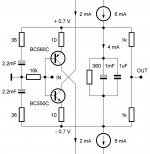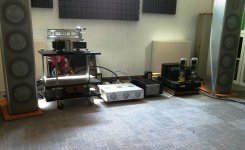I was surfing the net and stumbled on the F5 schematic. The TSSA has a lot in common. I am sorry i have not seen this one before.
What!!?
The difference is mainly that Nelson uses 2sk170 and 2sj74 in the input where the TSSA uses standard parts that are easy to get.
You have to see Juma's version using BJT.
Oh, they used hexfet, like mine, not latfet.
Last edited:
It is all simple music, but it does it very good. It is our taste.... My wife and i.
Gladly you enjoyed the evening, suppose the wine and some tasty snack weren't missing ... and all that still without mosfet drivers
Thanks for the complements Nico. As you know it requires a lot of man hours just for small modifications. The last little modification and test took 10 to 11 hours. So your comment is a vitamine injection to continue.
I would say that the SSA or the TSSA has potential but it needs a lot of housekeeping. This thread and the work i have done in conjuction with MiiB prooves it.
Together i have used more than 150 hours on it. Sure Andrej has a very stable amplifier running on the SSA design.
MiiB has a prototype too on the Basis of the SSA design.
It is Technology that is not for rookies. If any one would work with current feedback and on the same time is a newbie i would suggest replacing the frontend with a simple diamond buffer or a jfet buffer like in the pass firstwatt F5.
You would get simelar result but with an easier circuit.
I would say that the SSA or the TSSA has potential but it needs a lot of housekeeping. This thread and the work i have done in conjuction with MiiB prooves it.
Together i have used more than 150 hours on it. Sure Andrej has a very stable amplifier running on the SSA design.
MiiB has a prototype too on the Basis of the SSA design.
It is Technology that is not for rookies. If any one would work with current feedback and on the same time is a newbie i would suggest replacing the frontend with a simple diamond buffer or a jfet buffer like in the pass firstwatt F5.
You would get simelar result but with an easier circuit.
And the more detail and speed we heard from the Simple Symmetric ?
It may simply be that the Simple Symmetric has less damping factor so a peak in the impedance curve between tweeter and woofer may cause that effect by bringing out the presence range just a little. That also would explain the deeper soundstage of the Sauermann.
I do not have an impedance curve of the updated LQL200 so this is an estimation.
Maybe i can get the actual curve from the designer.
I think the amp-cable-speaker-room interface has to be considered as system or we are in muddy waters.
I tend to agree with you.
I have made a comparison with my simple cfb amp with exicon output devices.the AMP has been upgraded with predrivers as shownin my thread on the AMP. The servo Has a lower cutoff than the prototype which Michael and Lars was complaining about missing bas information. A resistor was 10x smaller than what was the intention.
A comparing between these to on a speaker reveals where the TSSA adds a little colouration. but it is very little and i Like it two.
I would say it is as you where comparing a between Audi rs4 and a BMW m3. They are both a good car.
Let' s just not forget what's SSA principle all about, it's all about simplicity in symmetry. Basic input current feedback SSA core from the pic is well tested and can be the base for many type of VAS front-end-s. Forthcoming CSA will be the most complex version based on SSA core and I believe also the best all-rounder of them all. 
Attachments
Odd combination.
You think? Look what was in a possession of a man who bought SSA amp.
Attachments
The result will be more or less like this:
I would say it is as you where comparing a between Audi rs4 and a BMW m3. They are both a good car.
This Wednesday it will be tested against an AR VT100 on JMLAB grand Utopia.
I am excited to get the judge!
So it is judge day.
It was compared against the AR system with AR preamp, AR VT100 and AR cd player as source.
In comparison with his signal path from CD to speaker it has the exactly same sound profile as the AR.
There was no presence if audible range at all.
He said it was like listening in slowmotion. You can here everything so that it feels like slowmotion.
There was only a little less wide stereo image but we are talking micro differences.
The level of detail is very high. The AR did have a little more fairydust.
But we talk a AR preamp and power amp worth >20000€
A wish would be a little more headroom -> more power.
A wish would be a little more headroom -> more power.
4 Ohm tap, ha ?
- Home
- Amplifiers
- Solid State
- TSSA - The Simplest Symmetrical Amplifier


